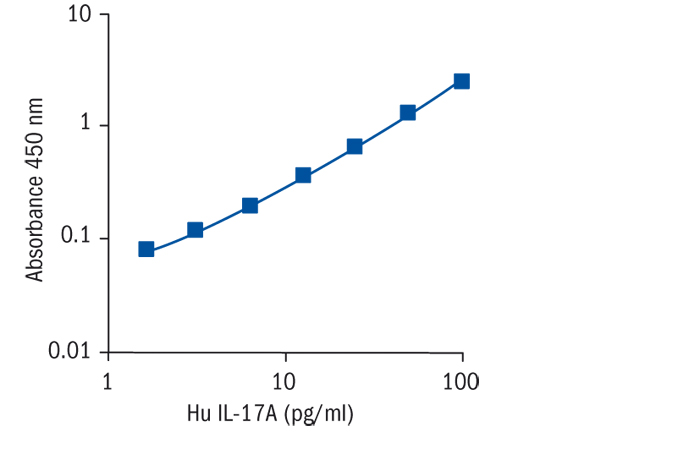Type
Sandwich ELISA, Biotin-labelled antibody
Description
The human IL-17A ELISA is an enzyme-linked immunosorbent assay for the quantitative detection of human IL-17A. The human IL-17A ELISA is for research use only. Not for diagnostic or therapeutic procedures.
Applications
Serum, Plasma-Heparin, Plasma-Citrate, Cell culture supernatant
Sample Requirements
50 µl/well
Shipping
On blue ice packs. Upon receipt, store the product at the temperature recommended below.
Storage/Expiration
Store the complete kit at 2–8°C. Under these conditions, the kit is stable until the expiration date (see label on the box).
Calibration Curve
Calibration Range
1.6–100 pg/ml
Limit of Detection
0.5 pg/ml
Intra-assay (Within-Run)
CV = 7.1%
Inter-assay (Run-to-Run)
CV = 9.1%
Spiking Recovery
serum 107.0%, heparin plasma 50.8%, citrate plasma 75,5%, cell culture supernatant 113.6%
Dilution Linearity
plasma 107.8%, cell culture supernatant 81.60%
Specificity
The interference of circulating factors of the immune systeme was evaluated by spiking these proteins at physiologically relevant concentrations into serum. There was no crossreactivity detected.
Features
- RUO
- calibration range 1.6-100 pg/ml
- limit of detection 0.5 pg/ml
- intra-assay CV = 7.1%
- inter-assay CV = 9.1%
Research topic
Cytokines and chemokines and related molecules
Summary
A new family of cytokines, Interleukin-17, has recently been defined that reveals a distinct ligand-receptor signaling system. There is high evidence for its importance in the regulation of immune responses. IL-17A was first characterised and six IL-17 family members (IL-17A-F) have subsequently been described. IL-17A, a homodimeric cytokine of about 32 kDa, is largely produced by activated memory T lymphocytes, but stimulates innate immunity and host defense. IL-17A and IL-17F both mobilize neutrophils partly through granulopoeisis and CXC chemokine induction, as well as increased survival locally. IL-17A and IL-17F production by T lymphocytes is regulated by IL-23 independent of T cell receptor activation. The T help 1 (Th1) and Th2 cell classification has until recently provided the framework for understanding CD4(+) T cell biology and the interplay between innate and adaptive immunity. Recent studies have defined a previously unknown arm of the CD4(+) T cell effector response, the Th17 lineage. This subset of T cells produces interleukin 17, which is highly proinflammatory and induces severe autoimmunity. Whereas IL-23 serves to expand previously differentiated T(H)-17 cell populations, IL-6 and transforming growth factor-beta (TGF-beta) induce the differentiation of T(H)-17 cells from naive precursors. Increasing evidence shows that IL-17 family members play an active role in inflammatory diseases, autoimmune diseases, and cancer. The IL-17 signaling system is operative in disparate tissues such as articular cartilage, bone, meniscus, brain, hematopoietic tissue, kidney, lung, skin and intestine. Thus, the evolving IL-17 family of ligands and receptors may play an important role in the homeostasis of tissues in health and disease beyond the immune system. Increased levels of IL-17 have been associated with several conditions, including airway inflammation, rheumatoid arthritis, intraperitoneal abscesses and adhesions, inflammatory bowel disease,allograft rejection, psoriasis, cancer and multiple sclerosis.
Find documents for the lot
Example Instructions for Use (RUO)
Example Instructions for Use (RUO)
Safety Information (RUO)
MSDS (RUO)

